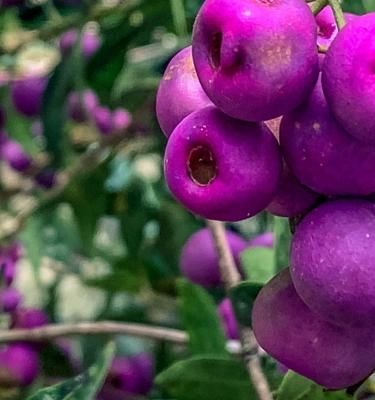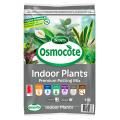

How to grow & care for Lilly Pilly
Lilly Pilly plants range from small shrubs to large trees - you can grow them in the ground or pots and you’ll find a Lilly Pilly for nearly any garden situation! Lilly Pilly are often grown as screen hedges because of their dense foliage, but they can also be grown for their interesting foliage - many cultivars have leaves with a weeping habit, while others send up bright red new growth above older green leaves.
Lilly Pilly flowers vary in size from small and insignificant to large and pom-pom like! If the flowers aren’t trimmed off (which commonly happens on many Lilly Pilly hedges) they’ll form into purple/magenta berries. While fruit from all Lilly Pilly plants is edible, some are more tasty than others. If you want to grow Lilly Pilly to harvest the berries for eating, choose Syzgium australe.
The common name ‘Lilly Pilly’ is used for 3 different genus including Syzygium species, Acmena species and Waterhousia species - recently many Acmena have been reclassified as Syzygium species….so it can be a little confusing!
Top 5 steps to growing Lilly Pilly
- Choose a full sun to part shade spot for your Lilly Pilly.
- Lilly Pilly will tolerate a range of soil conditions, but they’ll do best in a rich soil that’s free draining.
- Smaller Lilly Pilly will happily grow in pots, just use a suitable potting mix like Scotts Osmocote Premium Potting Mix and choose a pot with good drainage
- Fertilise Lilly Pilly at least twice a year in spring and autumn with a premium fertiliser like
- Not all Lilly Pilly are frost tolerant, choose one that suits your climatic conditions if you have cooler winters.
Shopping List
- A Lilly Pilly plant to suit your climatic conditions and garden size
- Scotts Osmocote Plus Organics All Purpose (including Natives) Plant Food & Soil Improver
- Scotts Osmocote Compost Premium Soil Improver
- Garden Shovel
- If growing in pots, you’ll need Scotts Osmocote Premium Potting Mix + Scotts Osmocote Plus Organics All Purpose (including Natives) Plant Food & Soil Improver and a suitable pot or container
- Mulch
- Defender Pyrethrum Insect Spray
Preparation
Lilly Pilly need a full sun to part shade position, sheltered from strong winds and heavy frosts. They’ll tolerate a range of soil conditions, but Lilly Pilly will perform best if the soil is free draining and rich in nutrients and organic matter.
Prepare the soil for planting Lilly Pilly by mixing Scotts Osmocote Compost Premium Soil Improver and Scotts Osmocote Plus Organics All Purpose (including Natives) Plant Food & Soil Improver through the soil in your chosen area.
Planting in the garden
Plant your Lilly Pilly into the prepared soil - dig the hole twice as wide as the original pot and the same depth. Gently remove the Lilly Pilly from the nursery pot and tease the roots lightly if they are compact.
Plant into the hole and backfill around the plant. Water in well and keep the soil moist for the first few weeks after planting to help establish new roots.
Mulch around the drip zone of Lilly Pilly to retain moisture and suppress weeds, but keep the mulch away from the main stem.
Planting in pots
Lilly Pilly can be grown in large pots or planters with good drainage - choose a pot that’s at least 2 to 3 times bigger than the original nursery pot. Select a small growing Lilly Pilly variety, suitable for growing in pots and position the pot in a full sun to part shade spot.
Fill your pot or planter with Scotts Osmocote Premium Potting Mix. Gently remove the Lilly Pilly from the nursery pot and tease the roots lightly if they are compact. Plant the Lilly Pilly into the potting mix and backfill around the plant. Water in well and mulch over the surface of the potting mix to help retain moisture, but keep the mulch back from the plants main stems.
Fertilising & Care
Lilly Pilly will benefit from fertilising 2-3 times per year in spring, summer and autumn with Scotts Osmocote Plus Organics All Purpose (including Natives) Plant Food & Soil Improver. If you live in a warm climate and your Lilly Pilly continue to actively grow throughout winter they can be fertilised then too.
Large and tall Lilly Pillies that you want to grow into trees generally don’t need pruning as they naturally have a nice shape. If however, you’re growing a Lilly Pilly hedge it should be tip pruned from a young age and encouraged to grow thick and bushy with lots of branching, rather than tall and straight with minimal side branching. Encouraging bushy side growth on your Lilly Pilly hedge from a young age, with regular side and top pruning, will ensure a dense hedge later on.
Small or potted Lilly Pillies can be pruned regularly to keep their shape and size as needed.
Pests & Diseases
Psyllids are one of the most common pests attacking Lilly Pilly plants. These tiny pests go for the soft, young growth and cause unsightly pimple-like distortions on the leaves. The Syzygium are the most susceptible to psyllids, although some varieties are being bred for psyllid resistance. To control psyllids, prune off all damaged leaves and seat it into a plastic bag, before disposing of it in a garbage bin.
If you notice ants or sooty mould on your Lilly Pilly plants it’s likely to be caused by a sap sucking pest like aphids. The ants are attracted to the sweet excretions of the sap sucking pests and the sooty mould is a secondary problem that coats leaves in a black/sooty residue. Use Defender Pyrethrum Insect Spray to control the aphids and other sap sucking pests and this will in turn control the sooty mould and ants.




